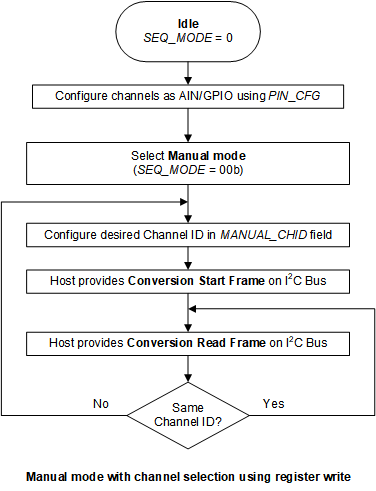ZHCSJS9 May 2019 TLA2528
ADVANCE INFORMATION for pre-production products; subject to change without notice.
- 1 特性
- 2 应用
- 3 说明
- 4 修订历史记录
- 5 Pin Configuration and Functions
- 6 Specifications
-
7 Detailed Description
- 7.1 Overview
- 7.2 Functional Block Diagram
- 7.3 Feature Description
- 7.4 Device Functional Modes
- 7.5 Programming
- 7.6
TLA2528 Registers
- 7.6.1 SYSTEM_STATUS Register (Address = 0x0) [reset = 0x80]
- 7.6.2 GENERAL_CFG Register (Address = 0x1) [reset = 0x0]
- 7.6.3 DATA_CFG Register (Address = 0x2) [reset = 0x0]
- 7.6.4 OSR_CFG Register (Address = 0x3) [reset = 0x0]
- 7.6.5 OPMODE_CFG Register (Address = 0x4) [reset = 0x0]
- 7.6.6 PIN_CFG Register (Address = 0x5) [reset = 0x0]
- 7.6.7 GPIO_CFG Register (Address = 0x7) [reset = 0x0]
- 7.6.8 GPO_DRIVE_CFG Register (Address = 0x9) [reset = 0x0]
- 7.6.9 GPO_OUTPUT_VALUE Register (Address = 0xB) [reset = 0x0]
- 7.6.10 GPI_VALUE_LSB Register (Address = 0xD) [reset = 0x0]
- 7.6.11 SEQUENCE_CFG Register (Address = 0x10) [reset = 0x0]
- 7.6.12 CHANNEL_SEL Register (Address = 0x11) [reset = 0x0]
- 7.6.13 AUTO_SEQ_CHSEL Register (Address = 0x12) [reset = 0x0]
- 8 Application and Implementation
- 9 Power Supply Recommendations
- 10Layout
- 11器件和文档支持
- 12机械、封装和可订购信息
7.4.2 Manual Mode
Manual mode allows the external host processor to directly select the analog input channel. Figure 7 lists the steps for operating the device in manual mode.
 Figure 7. Device Operation in Manual Mode
Figure 7. Device Operation in Manual Mode Provide an I2C start or restart frame to initiate a conversion, as shown in the conversion start frame of Figure 8, after configuring the device registers. ADC data can be read in subsequent I2C frames. The number of I2C frames required to read conversion data depends on the output data frame size; see the Output Data Format section for more details. A new conversion is initiated on the ninth falling edge of SCL (ACK bit) when the last byte of output data is read.
 Figure 8. Starting a Conversion and Reading Data in Manual Mode
Figure 8. Starting a Conversion and Reading Data in Manual Mode